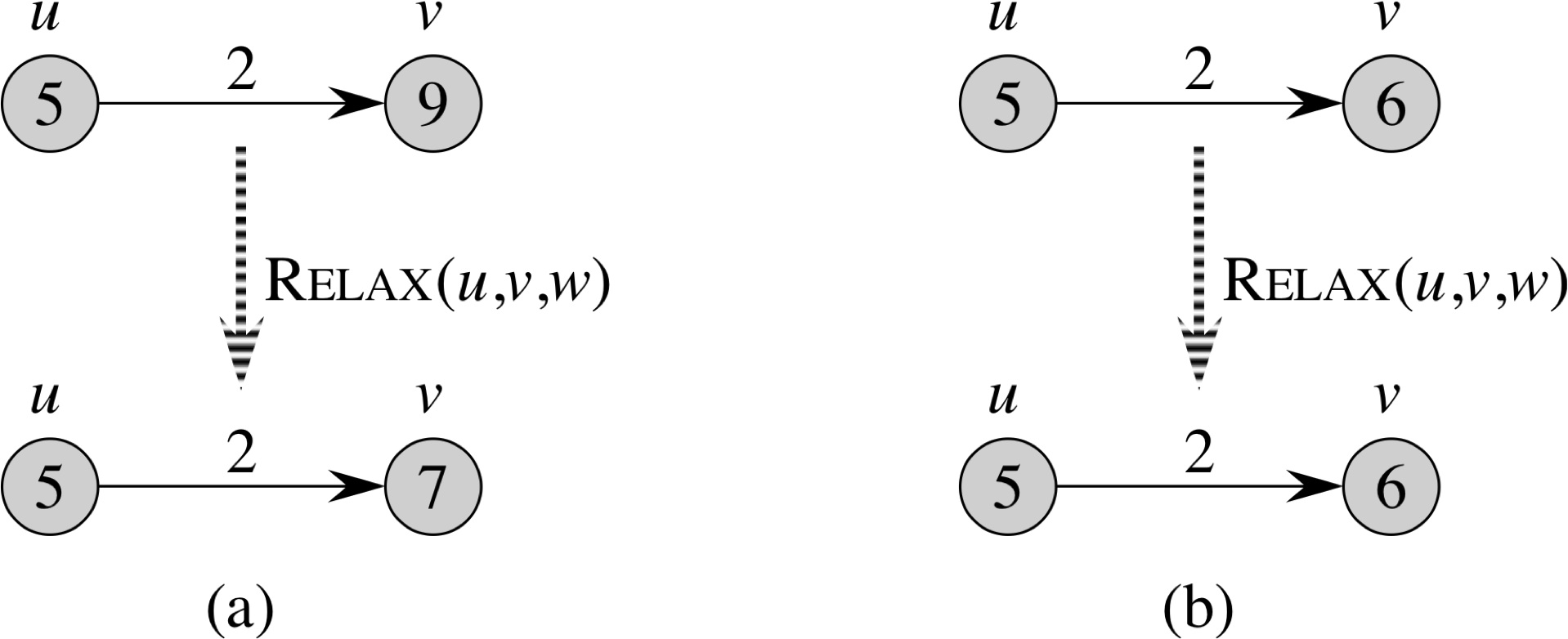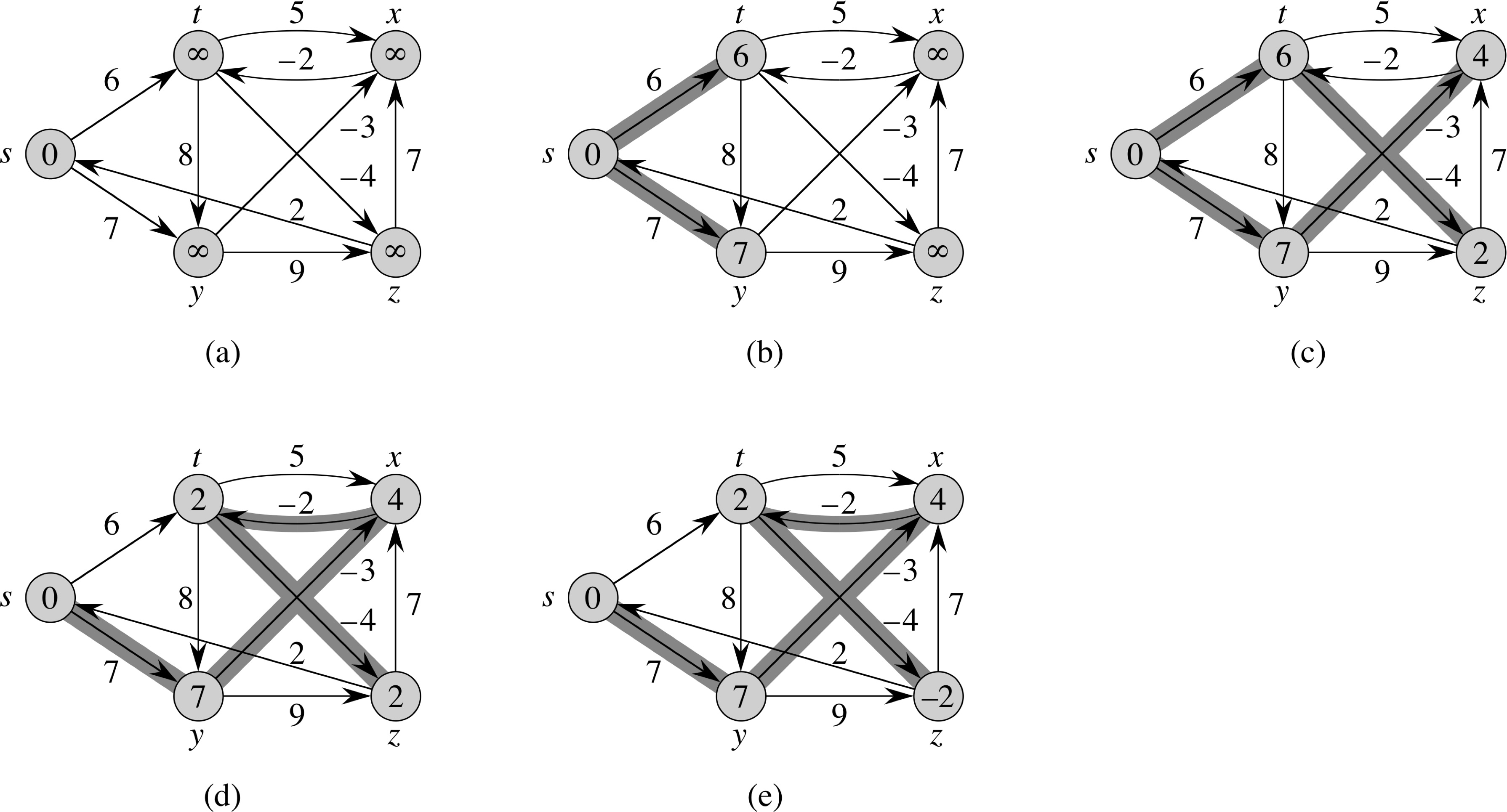Graph Algorithms
B403: Introduction to Algorithm Design and Analysis
Representing Graphs: Undirected

Representing Graphs: Directed

Finding Universal Sink
Is-Sink(A, k)
1 let A be |V|×|V|
2 for j = 1 to |V|
3 if akj == 1
4 return FALSE
5 for i = 1 to |V|
6 if aik == 1 and i ≠ k
7 return FALSE
8 return TRUE
|
Universal-Sink(A) 1 let A be |V|×|V| 2 i = j = 1 3 while i≤|V| and j≤|V| 4 if aij == 1 5 i = i + 1 6 else j = j + 1 7 if i > |V| 8 return “no universal sink” 9 elsif Is-Sink(A,i) == FALSE 10 return “no universal sink” 11 else return i “is a universal sink” |
Quick Recap
- Breadth First Search
- Start at a node s
- O(|V|+|E|) time
- Use a queue to maintain unvisited vertices
- Annotate each node u with u.d, which represents the shortest path from s to u
- Build a predecessor sub-graph (It is actually a tree. Why?)
- Depth First Search
- May repeat at multiple vertices (unlike BFS)
- Annotate each vertex, u, with discovered (u.d) and finished (u.f) times; u.d < u.f
- Predecessor graph is a depth-first forest
Properties of DFS
Theorem (Parenthesis Theorem) In any depth-first search of a directed or undirected graph G = (V,E), for any two vertices u and v, exactly one of the following three conditions holds:
- The intervals [u.d, u.f] and [v.d, v.f] are entirely disjoint; or
- The interval [u.d, u.f] is contained entirely in [v.d, v.f], and u is a descendant of v in a depth-first tree; or
- The interval [v.d, v.f] is contained entirely in [u.d, u.f], and v is a descendant of u in a depth-first tree.
DFS: Example

DFS: Four Types of Edges
- Tree edges: Part of the depth-first forest
- Back edges: (u.v) connecting u to an ancestor, v, of u
- Forward edges: Non-tree edge (u,v) connecting u to a descendant, b, of u
- Cross edges: All other edges
Theorem In depth-first search of an undirected graph every edge is either a tree edge or a back edge.
Claim An undirected graph is cyclic if an only if there exist back edges after a depth-first search of the graph.
Topological Sort

Topological-Sort(G) 1 call DFS(G) to compute finishing times v.f for each vertex v 2 as each vertex is finished, insert it onto the front of a linked list 3 return the linked list of vertices
Why does this work?
Questions
- Give a linear-time algorithm to find the number of simple paths from vertex s to vertex t in a DAG.
- Give an algorithm that determines whether or not a give undirected graph G = (V,E) contains cycle in O(|V|) time.
- Suppose we attempt to topologically sort a graph by repeatedly removing a vertex with in-degree 0 and all its outgoing edges. Why does this work? What happens if the graph has cycles?
Strongly Connected Components

Strongly Connected Components
Strongly-Connected-Components(G) 1 call DFS(G) to compute finishing times u.f for each vertex u 2 compute GT 3 call DFS(GT), but in the main loop of DFS, consider the vertices in order of decreasing u.f 4 output the vertices of each tree in the depth-first forest formed in line 3 as a separate strongly connected component
Why Does the Algorithm Work?
Lemma Let C and C' be distinct strongly connected components in directed graph G = (V,E), let u, v ∈ G, let u', v' &isin C', and suppose that G contains a path u→u'. Then G cannot also contain a path v'→v.
Definition If U ⊆ V, then d(U) = minu∈U {u.d}, and f(U) = maxu∈U {u.f}
Lemma Let C and C' be distinct strongly connected components in directed graph G = (V,E). Suppose that there is an edge (u,v) ∈ E, where u ∈ C and v ∈ C'. Then f(C) > f(C').
Corollary Let C and C' be distinct strongly connected components in directed graph G = (V,E). Suppose that there is an edge (u,v) ∈ ET, where u ∈ C and v ∈ C'. Then f(C) < f(C').
Single-Source Shortest Paths
Given a weighted, directed graph G = (V,E), with weight function w: E → ℜ. The weight w(p) of path p = ⟨v0, v1, ..., vk⟩ is the sum of the weights of its constituent edges:
w(p) = Σki=1 w(vi−1,vi)
Define the shortest-path weight δ(u,v) from u to v by:
| δ(u,v) = { | min{w(p) : p is path u→v} | if there is a path from u to v |
| ∞ | otherwise |
A shortest path from vertex u to vertex v is any path p with weight w(p) = δ(u,v)
Subpaths are Shortest Paths
Lemma Given a weighted, directed graph G = (V,E) with weight function w: E → ℜ, let p = ⟨v0, v1, ..., vk⟩ be a shortest path from vertex v0 to vk and, for any i and j such that 0 ≤ i ≤ j ≤ k, let pij = ⟨vi, vi+1, ..., vj⟩ be the subpath of p from vertex vi to vj. Then pij is a shortest path from vi to vj.
Proof By cut-and-paste argument, as before.
Observations
- Negative weight edges are fine
- Negative weight cycles cause the problem to be ill-defined. Why?
- Shortest paths can be represented using the predecessor sub-graph (as DFS-forests and BFS-trees)

Two Key Steps
Initialize-Single-Source(G, s) 1 for each vertex v ∈ G.V 2 v.d = ∞ 3 v.π = NIL 4 s.d = 0 |
Relax(u, v, w) 1 if v.d > u.d + w(u.v) 2 v.d = u.d + w(u,v) 3 v.π = u |

Bellman-Ford Algorithm
Bellman-Ford(G, w, s) 1 Initialize-Single-Source(G, s) 2 for i = 1 to |G.V|-1 3 for each edge (u,v) ∈ G.E 4 Relax(u, v, w) 5 for each edge (u,v) ∈ G.E 6 if v.d > u.d + w(u,v) 7 return FALSE 8 return TRUE
Running Time = O(VE)

Shortest Path for DAGs
DAG-Shortest-Paths(G, w, s) 1 topologically sort the vertices of G 2 Initialize-Single-Source(G, s) 3 for each vertex u, taken in topologically sorted order 4 for each vertex v ∈ G.Adj[u] 4 Relax(u, v, w)
Running Time = Θ(V + E)

Dijkstra's Algorithm
Dijkstra(G, w, s) 1 Initialize-Single-Source(G, s) 2 S = φ 3 Q = G.V 4 while Q ≠ φ 5 u = Extract-Min(Q) 6 S = S ∪ {u} 7 for each vertex v ∈ G.Adj[u] 8 Relax(u, v, w)
Running Time = O((V + E)⋅log(V)) (O(V⋅log(V) + E) achievable)
